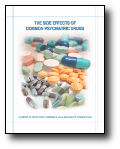There have been 4 studies done in the United States on Adderall. These studies are as follows:
United States, February 1, 2009: Pediatrics published a study that found spontaneous case reports of patients treated for ADHD with amphetamine/dextroamphetamine (Adderall), atomoxetine (Straterra), or Methylphenidate (Ritalin/Concerta/Daytrana) indicated a likely causal association between each of these drugs and treatment-emergent onset of signs and symptoms of psychosis or mania, notably hallucinations, in some patients. The authors concluded, “Patients and physicians should be aware that psychosis or mania arising during drug treatment of attention-deficit/hyperactivity disorder may represent adverse drug reactions.” Source: Andrew D. Mosholder, MD, MPH, et al., “Hallucinations and Other Psychotic Symptoms Associated With the Use of Attention-Deficit/Hyperactivity Disorder Drugs in Children,” Pediatrics, Vol. 123, No. 2, pp. 611-616, February 2009.
United States, September 1, 2005: The Oregon Health & Science University, Evidence-Based Practice Center published a report that reviewed 2,287 studies, virtually every study conducted on “ADHD” drugs (including Adderall), and found that there were no trials showing the effectiveness of these drugs and that there was a lack of evidence that they could change “academic performance, risky behaviors, social achievements, etc.” Source: “Drug Class Review on Pharmacologic Treatments for ADHD,” Final Report, Oregon Health & Science University, Evidence-Based Practice Center, September 2005; M. Alexander Otto, “Are ADHD drugs safe?” The News Tribune, September 26, 2005.
United States, July 1, 2005: The National Center on Addiction and Substance Abuse at Columbia University issued a report showing that 15 million Americans were getting high on prescription drugs, painkillers and psychiatric drugs such as Xanax and the stimulants Ritalin and Adderall. Also, they were abusing these drugs more than cocaine, heroin and methamphetamines combined. Between 1992 and 2003, the number of 12-17 year olds abusing these drugs rose 212%. Teens who abused prescription drugs were 12 times more likely to use heroin, 14 times more likely to use Ecstasy and 21 times more likely to use cocaine, compared to teens that do not abuse such drugs. Source: “Under the Counter: The Diversion and Abuse of Controlled Prescription Drugs in the U.S.,” The National Center on Addiction and Substance Abuse at Columbia University, June 2005.
United States, April 21, 2005: Partnership for a Drug-Free America released its “Partnership Attitude Tracking Study” of teens in 2004 that found 10% (2.3 million) of teens had abused Ritalin and Adderall stating that ‘Generation Rx’ has arrived.” Source: “Partnership Attitude Tracking Study” of teens in 2004, 17th Annual report by Partnership for a Drug-Free America, 21 April 2005; “Survey: 1 in 5 teens getting high on medications, over-counter drugs,” NewsItem.com, May 2, 2005.
This brochure is a simple guide that documents the dangerous and deadly side effects of the drugs prescribed to millions of men, women and children diagnosed with bogus mental disorders.
Please note: No one should attempt to get off of psychiatric drugs without doctor’s supervision. To help find medical practitioners in your area, click here


 Download The Side Effects of Common
Download The Side Effects of Common
SHARE YOUR STORY/COMMENT